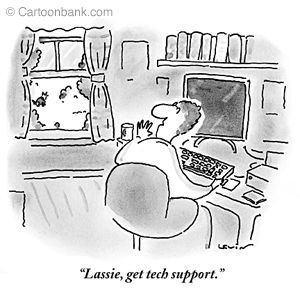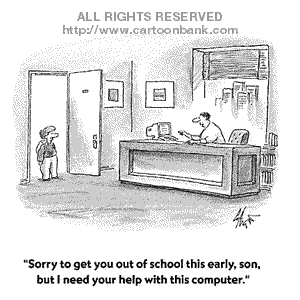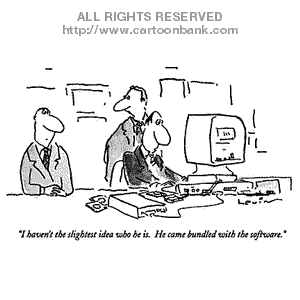The Classroom Roundtables at the Forum 2006
Using Technology to Prepare Students for the AP English Exam Presented by Bill Sullivan
Roundtable Description, November 11, 2006:
- Using Technology to Prepare Students for the AP English Exam
Technology enhances the AP English classroom and engages the twenty-first century student. Web pages and curricular sites replace paper handouts to support instruction. Meanwhile, technology based assignments vary from web page design to multimedia links to PowerPoint documents that complement literature. Students can also utilize software to create AP style test questions for practice and review. Discuss methods for integrating technology into your classroom and discover computer-based assignments that will develop students' analytical skills for success on the AP English Exam.
Click here for a Word copy of the welcoming
one page handout.
return to top
English III Honors (this is our AP English track) Student Pages Include:
- Literary Terms Project;
- AP English Multiple Choice Questions;
- Shakespeare Sonnet Movies.
return to top
Some other digital samples from my students from the 2005-06 academic year:
Prompts for digital stories and poems:
- Poetry: find a favorite poem and create a digital story. Click here for the Academy of American Poets. http://www.poets.org
- Download the latest version of the essay prompts on the Common Application page: http://www.commonapp.org/
- Write about your personal mythology. Write about a childhood activity where you were so engrossed in the play that you did not notice time passing. You could also excavate an early memory from your childhood--perhaps a moment of which you were too young to remember--that family members tell and retell. What is that story? Why is it so important for you?
- During our spring term, my classes wrote essays for the essay contest, This I Believe; it is a recurring program on National Public Radio's Morning Edition. Because the contest asks Americans to reflect on their core beliefs, sharing these core values became another way to build better relationships among the students in my classroom.
return to top
Adjusting Students' (and adults') Mindsets When Using Technology
in the Classroom |

|
 |
Adjusting Mindsets; explain and discuss:
- Reflect on Robert Brook's insights (author of Raising Resilient Children) on crisis, danger and possibility (celebrate the Chinese characters); the etymology of resilience;
- revive the buddy system (we're working together in a community fashion versus competition for individual grades; everyone must help everyone else through the project;
- utilize the driver (have students take turns using the lead computer that is attached to the projector and have them voice out loud their problem solving steps); reflect on temperament, if necessary; otherwise, celebrate problems as learning opportunities.
- appreciate the good, old advice of relying on intuition for previous the "innovative" technology of mechanical flight: flying by the seat of one's pants;
- realize the environments that you already know before you learn a new system/software; in other words, what types of learning will you have to do: relearning? upgrading? unlearning? Know your technology literacy level.
- join the circle and allow these projects to become naturally student-centered work projects where the teacher can also engage students
to help create the criteria for assessment since technology assignments defy normal
grading standards: David Warlick has a create your own rubric on his page. Here's an interesting resource, Midlink Magazine, with examples of examples of student rubrics. Here's one from the San Mateo County Project-Based Learning page. Have your students either create individual rubrics per assignments or research other options.
- these projects allow me to role model my love for learning because there is a good chance that students
know more than me in various technology topics;
- students watch me follow my 21st century mentor (my Leonardo Da Vinci) for presenting information in an artful and honest fashion: Edward Tufte.
- can anyone share additional classroom methods to create classroom community and partnerships?
return to top
Classroom Management:
- Overall, it is important to have a trust discussion with students before
the groups and individuals go off on their own. You can also use Robert Brooks' model where he asks students to create conduct goals and misconduct consequences.
- This teacher has some great instructions for organizing the various steps
for a digital storytelling project. He is also working with fourth and fifth
graders in a public school in Lexington, MA.http://www.infotoday.com/MMSchools/jan02/banaszewski.htm
- Kenton County School system in Kentucky has a great web page that is a resource for students as well as teachers: http://www.kenton.k12.ky.us/DigitalStory/dstindex.htm#teachers
- Here is a link that walks teachers through the steps of scripting, filming, editing and showing a movie as a classroom project. http://kidsvid.altec.org/
- Try the NEA's "works4me" tips library; they have a whole section devoted to suggestions from real teachers using technology in the classroom. "There's a lot of talk about technology and education, but for many teachers, getting down to the nitty gritty of actually using it is another matter. For one thing, it takes time learn new software, and more time to decide how best to apply it. Here are concrete examples of how some teachers are integrating technology into their daily classroom life."
- There are many resources for teachers at the Education World Technology Center; here a little fun start to using technology in your classroom every day: http://www.educationworld.com/a_tech/tech/tech146.shtml
return to top
Seven Elements of a Digital Storytelling
The Center for Digital Storytelling set an interesting criteria that incorporates
the aspects of multimedia. Because multimedia presents so many different ways
to present a story, as useful guideline such as this one will help channel and
focus students' energies and ambitions.
They have synthesized these seven elements as a way to channel diverse backgrounds
and approach the digital storytelling process with a good general guideline.
I have had students make I-movies, and I will now begin criteria conversations
with these seven elements. The fun begins when you open the floor to students
to create the class standards before the project begins.
In the interest of time and convenience, click
here for a boiled down version of CDS' seven elements:
- Point of View
- Dramatic Question
- Emotional Content
- Gift of Your Voice
- Power of Soundtrack
- Economy
- Pacing
Brainstorming and Outlining a Digital Story
Click here for a great storyboard outline (pdf file)
designed by John Lambert.
return to top
Directions for I-Movie. Before you begin,
it is good to sit back and evaluate some I-Movie skills and techniques that you
probably already possess. I-Movie operates with a click and drag environment.
You will also be working with the Palette and Timeline,
so it is important that you understand those features as well as the concepts
of importing (images, sound, etc) and Sharing
(sometimes referred to as export in previous versions of I-Movie). That's it; now start!
return to top
NB Links and Ideas to prompt reflections and
conversations:
General discussion on incorporating technology in a meaningful way; how do these figures speak to your comfort for learning new technology environments? What is are the capabilities of your students to help show your new steps in technology?
General Discussion on Digital Storytelling:
Other Multimedia Links:
return to top
Search Tips: try these links on the web
to gather multimedia images, files, etc, for your digital story:
return to top
Copyright Information:
return to top
Great Source: I began collecting information about digital storytelling from John Lambert, Dana Atchley, Nina Mullen, The
Center for Digital Storytelling: They have a great web page in which
they present the fundamental steps with the metaphor of a cookbook
and display a great movie
example as a type of recipe as a goal for the showing the multimedia potentials. This center and subsequent Digital Storytelling Association has been at the core of the digital movement for some time.
- The Landmark web page; David Warlick, innovative teacher and enthusiastic speaker; realistic advocate for incorporating technology into the classroom.
- I find all of the books of Edward Tufte to be great sources because he looks at the presentation of all information as an art form. He also has some great critiques of Powerpoint.
Bill Sullivan; last updated November 8th, 2006 return to top




